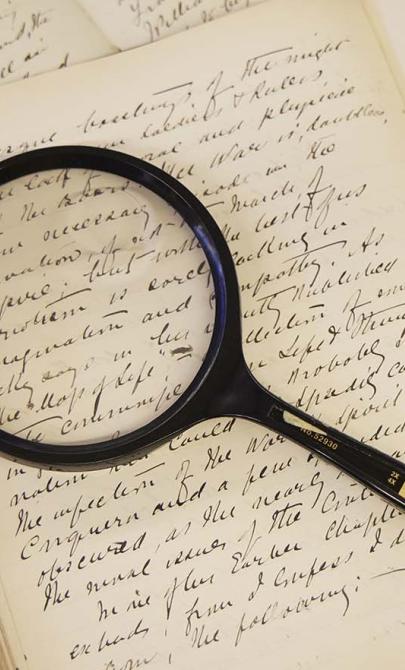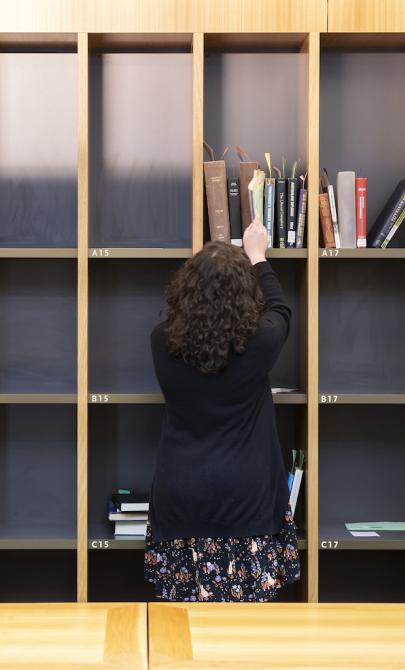Fitzhardinge Collection
Key items in the collection
The Fitzhardinge Collection of about 300 books can be divided into 2 parts. There are a number of incunabula and other early editions of classical texts, poetry and religious works. They include:
- Johannes Chrysostomus, Sermones XXV e Graeco e Lat. versi a Christoph Persona, Rome, 1470
- Roberto Caracciolo, Sermones clarissimi in sacra theologia, Venice, 1475
- Incipit ep[isto]la sancta hieronimi [sic] Paulinu[m] : presbite[orum] de omnib[us] diuine historie libris [Bible], Nuremburg, 1477
- Nicolaus Pergaminus, Dialogus creaturarum moralisatus, Gouda, 1480
- Saint Jerome, Incipit p[ro]logus Santi Hieronimi ... : in libros Vitaspatrum sancto[rum] Egiptioru[m] : etia[s] ero[rum] qui in Scithia Thebaida : atq[ue] Mesopotamia morati sunt
[Vitae partum], Nuremburg, 1483 - Jean Gerson, Secunda pars operum Johannis Gerson, Nuremburg, 1489
- Ovid, De arte amandi, Venice, 1494
- Girolamo Savonarola, Operetta molto diuota composta da frate Hieronymo da Ferrara, Florence, 1495
- Theocritus et Hesiod, Ta'de enesti en tede biblio ..., Venice, 1495
- Terence, [Terence' cu[m] directorio vocabuloru[m] sententiaru[m] artis comice, glosa iterlineali, cometariis Donato Guidone Ascensio.], Strasburg, 1499
- Petrach, [Li Sonetti, Canzone & Triumphi de Petrarcha : con li commenti ...], Venice, 1503
- Livy, Titi Liuii patauini Decades cum figuris nouiter impresse, Venice, 1511
- Livy, Romische historie Titi Liuij meniglich kurtzweilich vund dienstlich zu lesen, Mainz, 1514
- Aristotle, Ton en te'de te biblio : perie chomenon, onomata kai taxis. Aristotelous peri zoon historias ..., Florence, 1527
- Homer, Tes tou Homerou Odysseias : rerus, quid virtus, et quid sapientia possit, utile proposuit nobis exemplar Ulyssem, Glasgow, 1758
- Lucretius, Titi Lucretii Cari De rerum natura libri sex, Birmingham, 1772
- Alexander Pope, Poetical Works, Glasgow, 1785
The second group consists of limited-edition reprints, some of private presses, of celebrated English writers, mostly published in the second half of the 19th century and the first half of the 20th century. The writers include:
- Edmund Blunden
- Geoffrey Chaucer
- WH Davies
- Henry Fielding
- Robert Herrick
- John Keats
- Christopher Marlowe
- John Milton
- Sir Thomas More
- William Morris
- Christina Rossetti
- William Shakespeare
- Algernon Swinburne
- Lord Tennyson
- Anthony Trollope
- Edward Thomas
- Izaak Walton
- WB Yeats
Presses include:
- Kelmscott
- Gregynog
- Ashendene
- Golden Hours
- Halcyon
- Golden Cockerell
About Laurence Fitzhardinge
Laurence Frederic Fitzhardinge (1908–1993) was a historian, biographer and bibliophile who played a significant role in the development of Australian historical scholarship and collections.
Education and early career
Born in Sydney, Fitzhardinge was educated at Sydney Church of England Grammar School, the University of Sydney and New College, Oxford. Trained as a classicist, he maintained a lifelong interest in the field and published The Spartans in 1980. His professional career, however, focused mainly on Australian history.
In 1934, he joined the staff of the Commonwealth National Library and spent 10 years in charge of the Australian collections. In 1944, he became director of the School of Diplomatic Studies at Canberra University College before returning to the University of Sydney as a lecturer in classics. From 1950 until his retirement in 1973, he served as Reader in History at the Research School of Social Sciences, The Australian National University.
Historical research and publications
Fitzhardinge played a key role in acquiring the Groom papers for the Library and contributed to Nation Building in Australia: The Life and Work of Sir Ernest Littleton Groom (1941). In 1951, he began his major biographical project on former Prime Minister William Morris Hughes. This became a life’s work, culminating in 2 volumes: That Fiery Particle, 1862–1914 (1964) and The Little Digger 1914–1942 (1979). He also wrote several smaller works, including studies on early Canberra history.
Personal collection and legacy
Fitzhardinge inherited a valuable library from his father, James Eric Fitzhardinge (1877–1951), a solicitor with a deep interest in English literature. Laurence continued to collect books throughout his life, aided by his wife Verity Hewitt, a prominent Canberra bookseller.
Background to the collection
Fitzhardinge’s association with the Library extended over 60 years. Not long before his death, he stated that he wished the Library to receive part of his collection, the books that illustrated the history of printing.
Geoffrey and Charles Fitzhardinge, the sons of Fitzhardinge, donated the Fitzhardinge Collection under the Taxation Incentives for the Arts Scheme in 1994–95.
The Fitzhardinge Collection is held in he Rare Books Collection. The call numbers have the prefix RB FITZ (also RBf FITZ and RBRS FITZ). There is a presentation bookplate in each book.
After Fitzhardinge’s death, the large part of his collection that did not come to the Library, was sold and dispersed. It included a fragment of a 15th-century manuscript of Petrarch’s Epistolae Seniles, which Eric Fitzhardinge had acquired in 1934. It is described in KV Sinclair, Descriptive Catalogue of Medieval and Renaissance Western Manuscripts in Australia (1969, pp. 42–3). The manuscript was acquired by the Schǿyen Collection, a private collection in Oslo and London.
This guide was prepared using these references:
- Margaret Dent, A Man and His Books: The Library of L.F. Fitzhardinge, National Library of Australia News, vol. 5 (9), June 1995, pp. 6–9.
- Graeme Powell, Fitzhardinge, Laurence Frederic (Laurie) (1908-1993), Australian Dictionary of Biography Online




